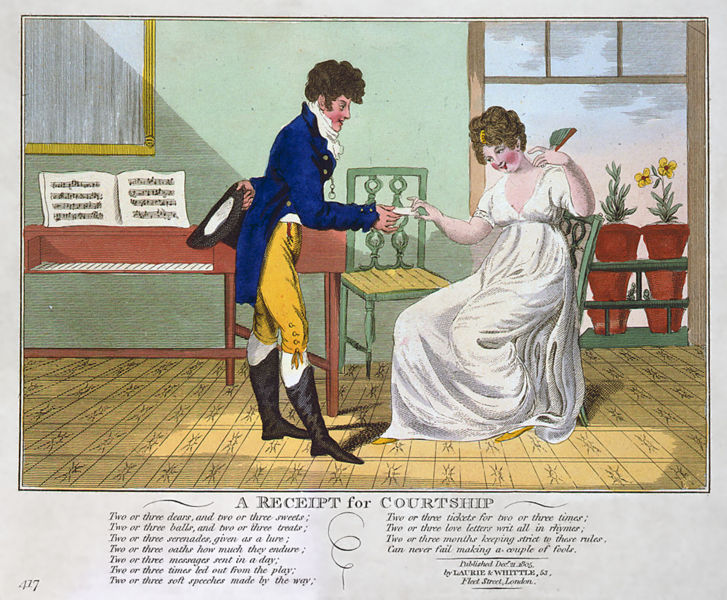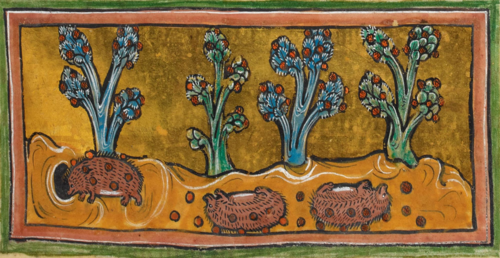Welcome to Carnivalesque #107! Carnivalesque is an interdisciplinary blog carnival dedicated to pre-modern history (to c. 1800 C.E.), and NOTCHES is delighted to be hosting the final edition of 2014. If you are already a NOTCHES reader, then fear not, there is plenty of material on the history of sexuality here! And if you’re new to NOTCHES, welcome! Do take a look at some of our own posts on medieval and early modern sexuality whilst you’re here…

We begin with two posts by Emily Brand, both of which provide helpful romantic advice. The first covers eighteenth-century seduction strategies, whilst the second has some useful seventeenth-century tips on how to keep a girlfriend. And for the beauty-conscious among us, perhaps the rather unpleasant-sounding concoctions described by Katherine Aske in her post on Puppy Water, Beauty’s Help might be of use?
The importance of personal appearance is also examined by Hannah Probert at the Medieval and Ancient Research Centre University of Sheffield blog. Her article on “Nancy Boys and Reluctant Warriors…with Combed, Anointed Hair”: Hair and Masculinity before and after the Norman Conquest explores the relationship between hair, masculinity and nationality in the decades around 1066. Hair is also the subject of Alun Withey’s blog on Beards, Whiskers and the History of Pogonotomy, a brief history of facial history since the sixteenth century.
This month has also produced a clutch of fascinating blogs on the history of health and disease. At Perceptions of Pregnancy, Victoria Leonard and Laurence Totelin examined the case of Megetia’s jaw, uncovering the story of an early medieval sufferer from hyperemesis gravidarum. Pregnancy-related problems were also the subject of Jennifer Evans’ Wellcome History blogpost on infertility in early modern England. Over at Early Modern Medicine, Evans wrote about Plague-Riddled Pigeons (on seventeenth-century plague cures), whilst Sarah Murden and Joanne Major tackled the 1775 Influenza Epidemic at All Things Georgian.
Anyone suffering from one of these ailments might have considered seeking a remedy from a medical practitioner. Benjamin Breen’s The Pharmaca of Jozeph Coelho: A Family of Converso Apothecaries in Seventeenth-Century Coimbra was one of several excellent blogs published by The Recipes Project this month. Richard Blakemore (aka Historywomble) was another blogger who choose to focus on the experiences of a family group: his subjects are the Trenchfields, an early seventeenth-century family of mariners.
Given their profession, the Trenchfields were surely interested in navigation, an interest they shared with Jane Squire. Squire, the only woman to respond to a 1714 call for schemes to find longitude at sea, is the subject of Alexi Baker’s The Lady of the Longitude at the Cambridge University Research Blog. They might also have made use of some of the methods of weather-forecasting discussed by The Renaissance Mathematicus in his post on The Weather and the Stars.
Back on dry land, The Many-Headed Monster has spent much of November in the pub, thanks to Mark Hailwood’s excellent mini-series on Alehouses Characters: The Jovial Good Fellow, The Drunken Constable and The Wastrel Husband. According to the British Library Medieval Manuscripts blog, medieval hedgehogs were also enthusiastic consumers of the fruit of the vine — the animation in How to be a Hedgehog is a must see! The same blog has also featured medieval lions this month. The big cats in A Royal Beast and the Menagerie in the Tower may not be as cute as the hedgehogs, but they are certainly impressive.

As patron saint of animals, St Francis of Assisi presumably liked both hedgehogs and lions, but it is his devotion to the ideal of poverty that forms the subject of Julia McClure’s post on St Francis – The First Hipster. Published by History Matters, the University of Sheffield’s excellent blog on ‘the history behind the headlines’, the post draws interesting points of comparison between the medieval and the modern. Debs Thorpe of The Scribe Unbound has also been pondering the relationship between past and present in a thought-provoking post on Trendy Scholarship: Medieval Manuscripts and the Public Imagination.
And finally, something seasonal from Eleanor Parker (A Clerk of Oxford), who has gathered some beautiful images and verse in her post on Medieval Annunciations.
 Katherine Harvey is Wellcome Trust Research Fellow at Birkbeck College, University of London, where her research focuses on the pre-Reformation English episcopate. Her first book, Episcopal Appointments in England, c. 1214- c. 1344, was published by Ashgate in January 2014, and she has also written several articles on the medieval episcopal body. Her current research project is ‘Medicine and the Bishop in England, c. 1100- c. 1500.’ She tweets from @keharvey2013
Katherine Harvey is Wellcome Trust Research Fellow at Birkbeck College, University of London, where her research focuses on the pre-Reformation English episcopate. Her first book, Episcopal Appointments in England, c. 1214- c. 1344, was published by Ashgate in January 2014, and she has also written several articles on the medieval episcopal body. Her current research project is ‘Medicine and the Bishop in England, c. 1100- c. 1500.’ She tweets from @keharvey2013

NOTCHES: (re)marks on the history of sexuality is licensed under a Creative Commons Attribution-NonCommercial-NoDerivatives 4.0 International License.
Based on a work at www.notchesblog.com.
For permission to publish any NOTCHES post in whole or in part please contact the editors at NotchesBlog@gmail.com





Thanks for the link to the Many-Headed Monster! And thanks passing along all the other links too: you’ve given me plenty of weekend reading.
My pleasure- I really enjoy reading the Monster posts! And am glad you enjoyed the Carnivalesque post.
Really like the detail and links you provide, your postings are very nicely put together !